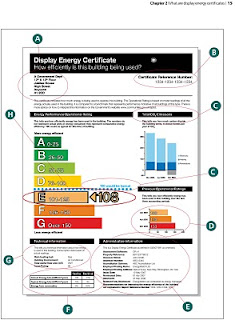
Last week, David Cameron, not for the first time, said that government departments and publicly-funded bodies must improve their energy efficiency in order to save public money and become greener.
Now, thanks to freedom of information requests, the Centre for Sustainable Energy has made it possible for us to see exactly how all these buildings are actually performing.
Alarmingly, some of the worst offenders are in the environment sector and some appear not to have submitted data at all: neither the Department for Energy and Climate Change (DECC) nor the Treasury are amongst the government offices included in the list of tens of thousands of buildings.
However, the Department of the Environment, Farming and Rural Affairs (DEFRA) is, and its offices at 3-8 Whitehall Place achieve a miserable G. Some of its properties are better, including one in Norfolk which manages to achieve B, but the vast majority are below average.
By law, all public buildings of over 1,000m2 must display Display Energy Certificates. These grade the performance of buildings' energy efficiency in terms of CO2 emissions from A - (below 25 tonnes of CO2 per year) the best, to G - the worst (over 150 tonnes).
Disappointingly, there are just 142 A-rated buildings out of a total of 40,147. They include Birmingham City Council, Crown Prosecution Service buildings in Bradford, Leeds and Derby, English Heritage, H M Customs & Excise building in Ipswich, Parcelforce Worldwide and a couple of Royal Mail buildings, Royal Holloway University of London, the Science Museum Swindon.
Compared to this there are 6,112 G-rated buildings. The worst offenders amongst national bodies here are, sadly, the Environment Agency (3 buildings) and Defra (9 buildings including incl. 3-8 Whitehall Place). In addition, the Royal Mail, NHS, MoD, Metropolitan Police, HSE, HPA, FCO, DWP, DoH, DfT, Department for National Savings, CPS and the Benefits Agency all feature prominently as poor performers.
Of the national government departments, there are only a few with a B as well. HMR&C comes out on top with 8 buildings (although it also has 141 G rated ones) and there are also a DSS building in Cheltenham, with 9 Job Centre Plus shops, a disability benefit centre in Bristol and a Defra building in Alnwick.
The Department of Health, which really needs to save money, achieved only F and two Gs on its London buildings while none of the 18 DSS buildings got better than C, with one exception, a B.
There are clearly plenty of opportunities to reduce the energy bills of the government estate and save carbon emissions.
When a building receives its certificate, the buildings facility manager or energy manager will receive at the same time, a report advising them on what measures they can take to improve the performance of the building. This comes complete with payback time estimates for different measures to make it easy for them.
Amongst the measures that can be taken include those at little or no cost such as installing low-energy lightbulbs and turning off equipment when not used, not to mention switching to a renewable energy electricity tariff. Advice on these and other measures are available from the government-funded Carbon Trust.
No comments:
Post a Comment